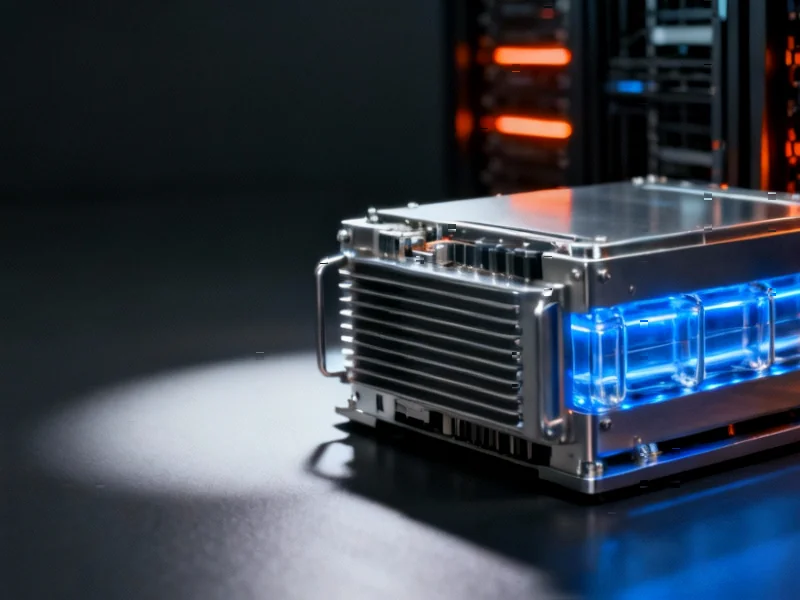The AI Power Challenge
As artificial intelligence transforms industries, the massive computational workloads required are creating unprecedented demands for reliable, scalable electricity, according to industry analysis. Sources indicate that traditional power grids struggle to keep pace with AI’s dynamic energy requirements, prompting data center operators to explore alternative generation solutions.
Table of Contents
Transmission and distribution infrastructure reportedly cannot evolve as rapidly as AI technology, creating bottlenecks for power delivery. This challenge is driving increased interest in onsite power generation, which allows facilities to produce electricity exactly where it’s needed rather than relying solely on aging grid systems.
Onsite Generation Gains Momentum
The shift toward decentralized power represents a significant change in how data centers approach energy sourcing, analysts suggest. Bloom Energy’s recent Data Center Power Report reportedly found that 27% of operators anticipate data centers becoming solely reliant on onsite power in the near future, a dramatic increase from just 1-2% a few years ago.
“In many ways, it allows data centers to own their destiny,” said Akhil Batheja, Bloom Energy’s director of technology strategy, according to the company’s report. “Operators can identify the exact solution that meets their unique requirements in a timely manner and effectively balance sustainability, reliability, and efficiency.”
Fuel Cell Technology Advantages
Among onsite generation options, fuel cells are emerging as a particularly promising solution for AI-driven facilities, the report states. Similar to how solar panels convert sunlight directly into electricity, fuel cells convert natural gas into electricity without combustion through a solid-state process that achieves 54% efficiency – reportedly the highest of any power conversion technology.
Industry analysis highlights three key sustainability benefits: higher efficiency requiring less fuel and producing less carbon dioxide, near-zero air pollutants due to non-combustion operation, and water-neutral performance during normal operation. Unlike other power systems affected by environmental conditions, fuel cells reportedly maintain consistent performance regardless of geography, temperature, humidity, or altitude.
Meeting AI’s Unique Demands
The technology’s adaptability extends to fuel sources as well, with fuel-agnostic systems capable of running on natural gas, biogas, or hydrogen. This flexibility allows operators to utilize whatever energy source is most readily available in their region.
For AI workloads that can fluctuate in milliseconds, fuel cells’ direct energy conversion process enables nearly instantaneous response – reportedly twice as fast as turbines and engines. This rapid load response is crucial for handling the dynamic computational demands of artificial intelligence applications.
Additionally, the compact nature of fuel cell systems supports high-density server configurations while addressing cooling challenges through waste heat utilization. “We can use waste heat from our fuel cells and run it through an absorption chiller, which turns that heat into cooling,” Batheja explained in the report.
Economic Considerations
While fuel cell technology was once considered a niche, expensive option, continuous innovation has dramatically improved its cost competitiveness, according to industry sources. The total cost of ownership has become increasingly favorable due to reductions in both capital expenditure and operating costs.
Reportedly, fuel cells are 15-20% more efficient than other onsite generation methods, significantly reducing fuel expenses – the largest component of operating costs. Combined with decreased need for overbuilding due to higher reliability, the technology offers clear economic advantages for data center operators.
The Future of Data Center Power
As AI continues to embed itself deeper into personal and professional life, the demand for scalable, reliable power will only intensify, analysts suggest. Fuel cell technology has matured from an experimental solution to a proven source of primary power that addresses both immediate capacity needs and long-term sustainability goals.
The industry shift toward diversified power sources, including onsite generation alongside traditional grid power, represents a fundamental change in how data centers approach energy strategy. With AI workloads showing no signs of slowing, the race to secure adequate, efficient power continues to drive innovation across the energy sector.
Related Articles You May Find Interesting
- OpenAI Debuts Enterprise Knowledge Integration for ChatGPT, Linking Google Drive
- Intel’s Financial Rebound Shifts Focus to Struggling Foundry Division
- Applied Materials Implements Global Workforce Reduction Affecting Over 1,400 Pos
- Boeing Strikers to Vote on Revised Contract Offer After 80-Day Walkout
- European Markets Set for Modest Gains as Earnings Season Intensifies
References
- https://www.bloomenergy.com/midyr-2025-data-center-report/
- https://www.bloomenergy.com/be-report-ai-race-fuel-cells/?utm_medium=referral…
- http://en.wikipedia.org/wiki/Fuel_cell
- http://en.wikipedia.org/wiki/Data_center
- http://en.wikipedia.org/wiki/Electricity_generation
- http://en.wikipedia.org/wiki/Artificial_intelligence
- http://en.wikipedia.org/wiki/Electrical_grid
This article aggregates information from publicly available sources. All trademarks and copyrights belong to their respective owners.
Note: Featured image is for illustrative purposes only and does not represent any specific product, service, or entity mentioned in this article.



